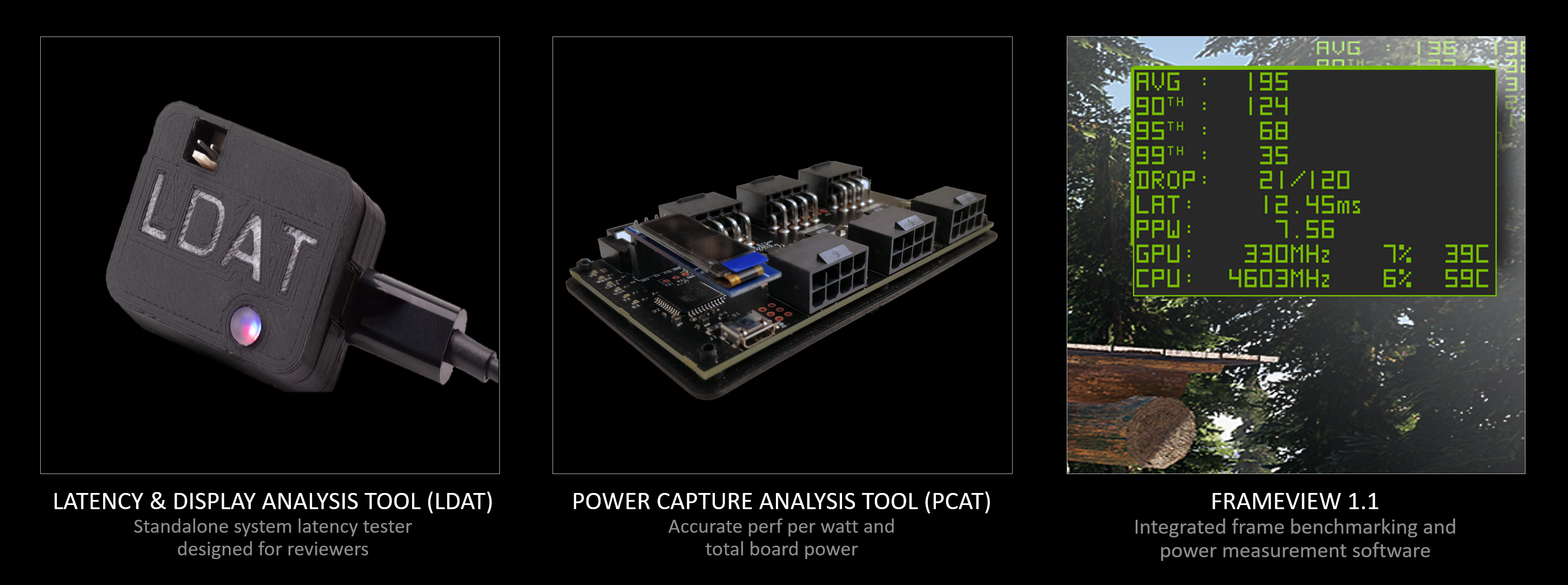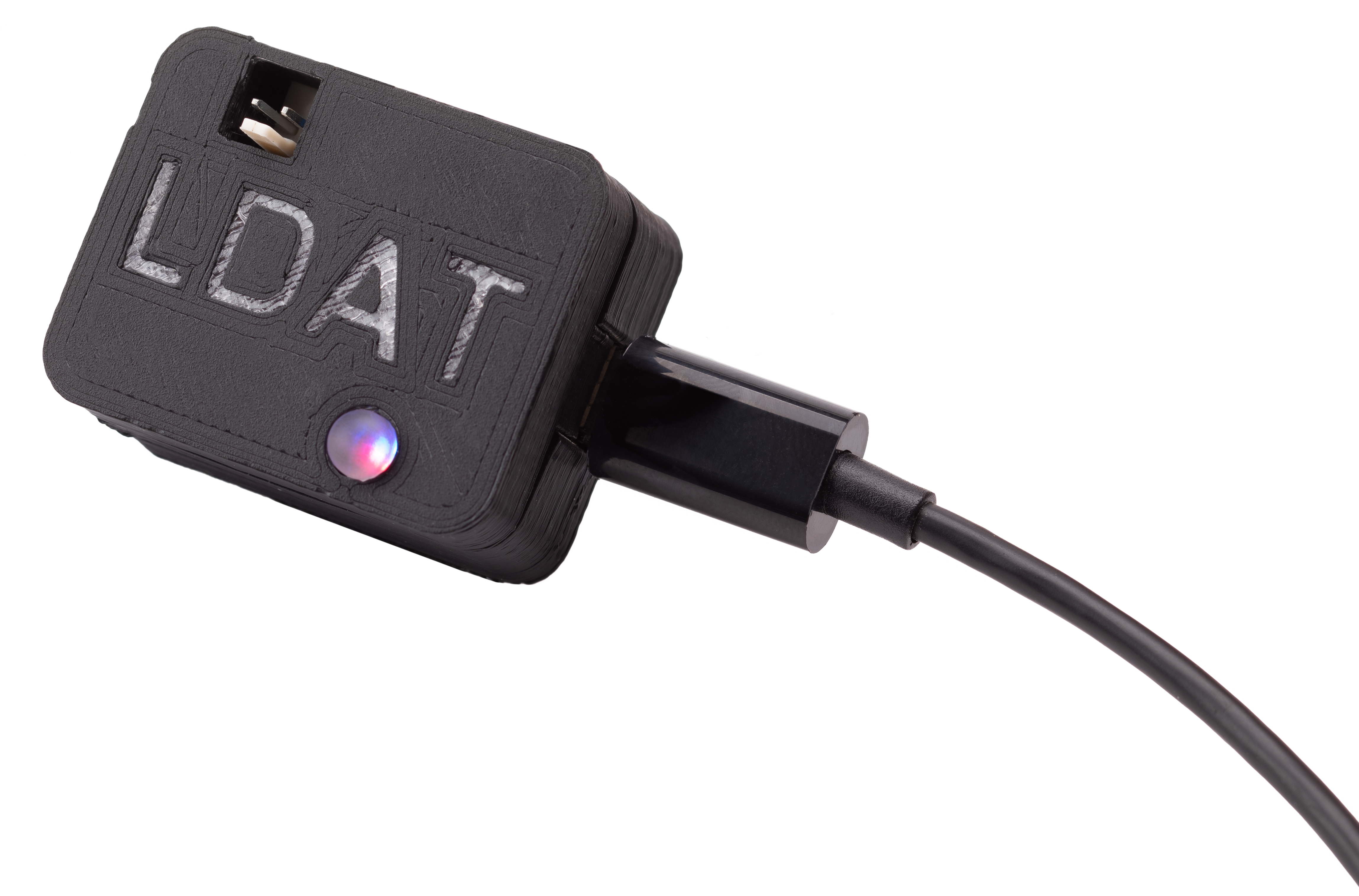NVIDIA Reviewer Toolkit for Graphics Performance
The most common performance metric in gaming and graphics is FPS. It’s easy to capture with a variety of tools, and provides a good gauge of GPU throughput. However, it is not the only metric that matters when assessing GPU performance.
Power and Latency are often overlooked because they are difficult to accurately measure and tend to be less relatable to viewers. Enter the NVIDIA Reviewer Toolkit for Graphics Performance - an easy to use suite of hardware and software tools designed to help reviewers measure and report power and latency metrics.
This toolkit provides three tools to measure GPU performance:
- Latency and Display Analysis Tool (LDAT) - used to measure end to end system latency
- Power Capture Analysis Tool (PCAT) - used to measure total GPU board power in isolation
- FrameView 1.4 - Improved version of FrameView that ties everything together
LDAT and PCAT are engineering tools that NVIDIA is sharing with reviewers to help them better evaluate hardware and games. We are covering them in this article so that gamers can understand how the tools work and why the data they provide matters to product reviews. They are similar in approach to FCAT - simple hardware tools with a lightweight software application user interface.
Let’s dive into each reviewer tool.
LDAT
Measuring end-to-end system latency traditionally requires recording the input and display using a high-speed camera and then counting the individual frames. This is both expensive and tedious.
To simplify the process of measuring system latency, NVIDIA has created an intuitive and powerful hardware latency measurement tool called LDAT (Latency Display Analysis Tool). LDAT is a discrete hardware analyser that uses a luminance sensor to quickly and accurately measure the motion-to-photon (click-to-muzzle flash) latency in a game or application. LDAT is cross platform and works with GPUs from all vendors.
LDAT adds a totally new dimension to measuring and tuning gaming performance, and can answer questions like: “How does resolution or certain in-game settings and effects impact overall end-to-end latency?”, or, “How can I tune settings to reduce latency and still maintain great image quality?”, or, “How does latency compare among different games I play, and which ones need more latency tuning than others?”. Capturing such data was complex and very time consuming in the past—if possible at all. LDAT makes this data available easily and quickly.
LDAT has been NVIDIA’s goto internal tool for latency measurement. With the launch of our new low latency technology, NVIDIA Reflex, we wanted to share our internal testing tool with reviewers so they can effectively and easily measure this important performance metric. LDAT can help test latency on a variety of displays, save time compared to the old high speed camera method, and increase accuracy of measurements. For gamers, we have new NVIDIA G-SYNC 360Hz Esports displays coming to market this fall that effectively have LDAT built directly into the monitor -- we call it the NVIDIA Reflex Latency Analyser, and it will put the power of system latency measurement directly into your hands for the first time!
PCAT
GPU power efficiency is critical for the success of a graphics architecture. With an efficient GPU, the graphics card outputs less heat and noise. Why is that important?
One way to increase performance is by reducing power consumption. That’s because a GPU is limited by the amount of heat it can dissipate, so an efficient design directly translates to peak performance. Performance-per-watt efficiency results in designs with higher performance, lower noise, more overclocking headroom, and greater framerates.
PCAT (Power Capture Analysis Tool) is a combination of hardware and software that provides accurate perf-per-watt and total graphics board power measurements. PCAT is designed to make the process of collecting and analysing power data very easy. This is accomplished with a PCI Express Riser that sits between the GPU and motherboard to gather data. That data is then sent to the PCAT Module, then finally to the software analyser.
This method of measuring power has many benefits:
- Easy to use PCIe graphics card power measurement
- Works with any GPU vendor (does not rely on private API calls)
- Direct measurement of total board power (no more guessing and extrapolating)
- Accurate to within one-thousandth of a watt (assuming reasonable voltages)
- No soldering required
This new, easy way to measure power enables reviewers to look at true GPU board power. Power APIs are not nearly as accurate and are typically not cross vendor and have different definitions of board power. For more details on power APIs, check our power primer. If you are looking to compare power efficiency between GPUs, PCAT is a great option for easily measuring total power power and efficiency insolation.
FrameView 1.4
For those who haven’t used FrameView, FrameView is NVIDIA’s software tool designed to capture and measure performance and power utilisation of PC-based graphics and CPU hardware. It’s especially useful for measuring frame rates and GPU power usage when running stressful “real world” PC gaming scenarios. FrameView captures performance and power data with minimal overhead so as not to impact frame rates or gameplay, and includes an overlay that shows performance and power metrics as a game is being played. It also allows benchmarks runs to be captured and charted in detailed reports.
In this release, there a number of new features and key changes:
- Logs and Summary files have been completely restructured based on user feedback. Summary files now contain references to each log file in that directory - making it truly a summary of the benchmarking session
- A new FrameView Excel Analyser template that consumes log files and automatically creates charts that can be stylized to the reviewers needs
- Vulkan Overlay support
- PCAT integration such that power metrics can be added to the logs directly from PCAT
- A new installer to make updating frameview easy
- New metrics: CPU metrics, Render Present Latency, and system parameters
To download FrameView, or for more information including the user guide, please head here.
Wrapping up
The NVIDIA Reviewer Toolkit for Graphics Performance offers reviewers an easy way to measure more than just FPS when assessing the performance of a GPU. Using new innovative tools like LDAT and PCAT, reviewers can increase the quality of their review by adding both power and latency to their host of tests. For gamers, that means reviewers and influencers can more effectively help you take these important factors into consideration when looking for your next upgrade.
FrameView 1.4 is available for download today. LDAT and PCAT are being made available to select tech reviewers around the globe to incorporate into hardware and game reviews.




